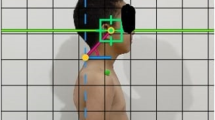Abstract
In order to evaluate the load on the low back of teachers in nursery schools, basic activity, working posture, child-lifting, and desk-lifting were analyzed for eight nursery teachers using video recording. The trunk inclination angle (TIA) was also measured continuously during full workshifts for 20 nursery teachers using an inclination monitor. The nursery teachers in the 0–1 (year) age class more often adopted low working postures, “sitting on the floor” and “kneeling,” while teachers in the 4–5 age class more frequently adopted high working postures, “standing” and “sitting on a chair.” The mean of TIA among all subjects was 20°. The time spent at a TIA of more than 20° represented 43% of the workshift. The mean and time distribution of TIA did not differ between the age classes. The frequency of trunk-lifting from severe bending forward (TIA > 45°) was 86 times/hour on average. The frequency of trunk-lifting was highest in the 0–1 age class. The number of times of child-lifting was 46 in the 0–1 age class, while it was 1 in the 4–5 age class.
Similar content being viewed by others
References
Andersson GBJ (1981) Epidemiologic aspects on low-back pain in industry. Spine 6:53–60
Andersson GBJ, Ortengren R, Herberts P (1977) Quantitative elect romyographic studies of back muscle activity related to posture and loading. Orthop Clin North Am 8:85–96
Burdorf A (1992) Sources of variance in exposure to postural load on the back in occupational groups. Scand J Work Environ Health 18:361–367
Frymoyer JW, Pope MH, Costanza MC, Rosen JC, Goggin JE, Wilder DG (1980) Epidemiologic studies of low-back pain. Spine 5:419–423
Kelsey JL, Golden AL (1987) Occupational and workplace factors associated with low back pain. Spine: State of the Art Reviews 2:7–16
Keyserling WM (1986) Postural analysis of the trunk and shoulders in simulated real time. Ergonomics 29:569–583
Kosugo R, Yoshitake H, Iida K (1976) The work of day-nursery school teachers (in Japanese). J Sci Labour 52:203–218
Kumagai S, Nakachi S, Hanaoka M, Kataoka A, Shibata T (1990) Work load of nursery teachers in a nursery school: relationship between age of children and work load (in Japanese with English abstract). Jpn J Ind Health 32:470–477
Laboratory of Physical Education, Tokyo Metropolitan University (1989) Physical fitness standards of Japanese people, 4th edn. Fumaidosyuppan, Tokyo
Merriam WF, Quinnell RC, Stockdale HR, Willis DS (1984) The effect of postural changes on the inferred pressures within the nucleus pulposus during lumbar discography. Spine 9:405–408
Nakaseko M, Tokunaga R, Hosokawa M (1982) History of occupational cervicobrachial disorder in Japan. J Human Ergol (Tokyo) 11:7–16
Nishiyama K, Sato K, Kondo Y, Nakaseko M, Hosokawa M, Tokunaga R (1979) Work and work load of nursery teachers in institutes for mentally and physically handicapped children. Arh Hig Rada Toksikol 30:1235–1242
Ortengren R, Andersson GBJ, Nachemson AL (1981) Studies of relationships between lumbar dies pressure, myoelectric back muscle activity, and intra-abdominal (intragastric) pressure. Spine 6:98–103
Punnett L, Fine LJ, Keyserling WM, Herrin GD, Chaffin DB (1991) Back disorders and nonneutral trunk postures of automobile assembly workers. Scand J Work Environ Health 17:337–346
Riihimaki H (1991) Low-back pain, its origin and risk indicators. Scand J Work Environ Health 17:81–90
Ryan GA (1989) The prevalence of musculo-skeletal symptoms in supermarket workers. Ergonomics 32:359–371
Seo A, Tsuru S, Kakehashi M, Yoshinaga F (1994) A simple apparatus using inclinometer for monitoring working postures. Jpn J Ind Health 36:406–411
Seo A, Udo H, Yoshinaga F (1993) Electromyogram measuring method for low back load evaluation of handling weight and forward bending posture (in Japanese with English abstract). Jpn J Ind Health 35:19–24
Videman T, Nurminen T, Tola S, Kuorinka I, Vanharanta H, Troup JDG (1984) Low-back pain in nurses and some loading factors of work. Spine 9:400–404
Wickstrom G, Niskanen T, Riihimaki H (1985) Strain on the back in concrete reinforcement work. Br J Ind Med 42:233–239
Author information
Authors and Affiliations
Rights and permissions
About this article
Cite this article
Kumagai, S., Tabuchi, T., Tainaka, H. et al. Load on the low back of teachers in nursery schools. Int. Arch Occup Environ Heath 68, 52–57 (1996). https://doi.org/10.1007/BF01831633
Received:
Accepted:
Issue Date:
DOI: https://doi.org/10.1007/BF01831633




